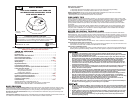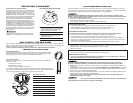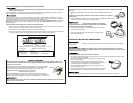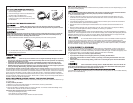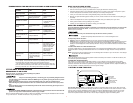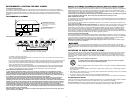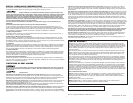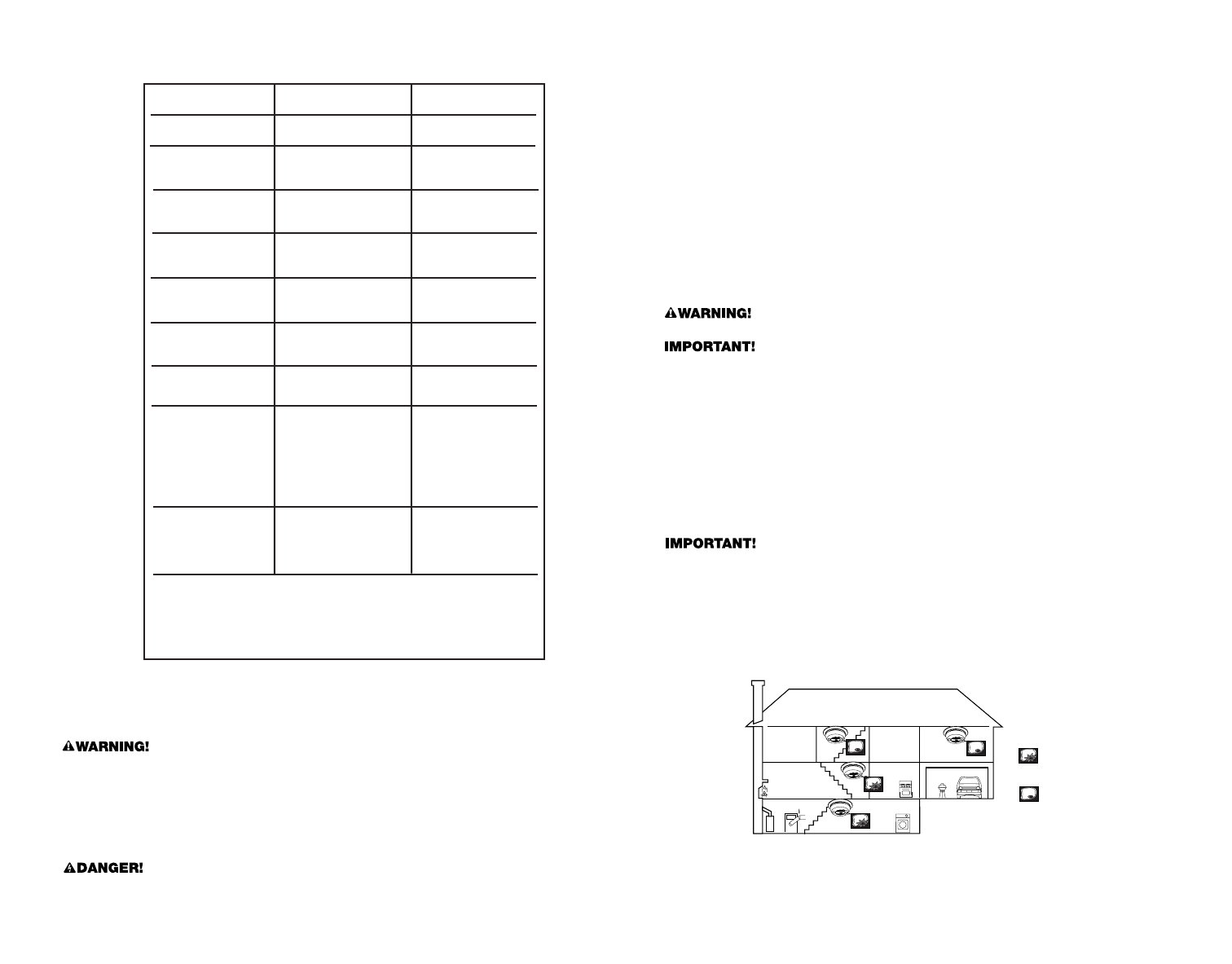
5
MALFUNCTION
(Unit MUST be
replaced)
LED flashes RED
rapidly three times, in
sync with three horn
“chirps”, once every
minute
Horn “chirps” three
times, in sync with
three LED flashes
ALARM CONDITION*
(Initiating Unit)
LED flashes RED, the
same pattern as the
horn
Audible alarm:
3 beeps, pause,
repeating horn pattern
AC POWER ON
(Normal operation)
LED shines GREEN
continuously
Silent; no audible
alarm
RESUME AC POWER
GREEN LED turns ON
Horn “chirps” one time
to signal resumption of
AC power
Condition
LED
Horn
LATCHING ALARM
ACTIVE**(Under AC or
DC Power)
LED flashes RED once
every 5 seconds
Silent; no audible
alarm
ALARM SILENCE
LED flashes RED once
every 5 seconds
No signal
LOW BATTERY
GREEN LED flashes
once every minute
Horn “chirps” once
per minute, in sync
with LED. NOTE: If the
battery is VERY LOW,
the horn may either
chirp once per sec-
ond, or sound
continuously
DC POWER
(Battery back-up
active)
LED flashes GREEN
once per minute while
battery powers unit
One horn “chirp” to
signal loss of AC
power
DURING TESTING
(Under AC or DC
power)
LED flashes RED, the
same pattern as the
horn
Audible alarm:
3 beeps, pause,
repeating horn pattern
UNDERSTANDING THE INDICATOR LIGHTS AND ALARM HORN PATTERNS
*When any Heat Alarm in an interconnected series triggers an alarm, its red LED
will flash rapidly. The red LEDs will not flash on any remaining alarms in the series.
This feature helps responders identify which unit(s) triggered the alarm.
**The Latching Alarm indicator is activated after an Alarm is exposed to alarm lev-
els of heat. After heat levels drop below alarm levels, the LED begins to flash RED
once every 5 seconds. See “The Latching Alarm Indicator” for details.
IF THIS HEAT ALARM SOUNDS
RESPONDING TO AN ALARM
During an alarm, you will hear a loud, repeating horn pattern:
3 beeps, pause, 3 beeps, pause.
• If the unit alarms and you are not testing the unit, it is warning you of a potentially dangerous situa-
tion that requires your immediate attention. NEVER ignore any alarm. Ignoring the alarm may result
in injury or death.
• Never disconnect the AC power or remove the battery back-up to quiet an unwanted alarm.
Disconnecting the power disables the alarm so it cannot sense heat. This will remove your protec-
tion.
• If the unit alarms and you are not absolutely certain of the source of the heat, get everyone out of
the house immediately.
•
ELECTRICAL SHOCK HAZARD: Attempting to disconnect the power connector from the unit when the
power is on may result in electrical shock, serious injury or death.
When an interconnected system of units is in alarm, the Red LED on the unit(s) that initiated the alarm will flash
in sync with the horn. The LED will not flash on any remaining units.
WHAT TO DO IN CASE OF FIRE
• Don’t panic; stay calm. Follow your family escape plan.
• Get out of the house as quickly as possible. Don’t stop to get dressed or collect anything.
• Feel doors with the back of your hand before opening them. If a door is cool, open it slowly. Don’t open a
hot door. Keep doors and windows closed, unless you must escape through them.
• Cover your nose and mouth with a cloth (preferably damp). Take short, shallow breaths.
• Meet at your planned meeting place outside your home, and do a head count to make sure everybody got
out safely.
• Call the Fire Department as soon as possible from outside. Give your address, then your name.
• Never go back inside a burning building for any reason.
• Contact your Fire Department for ideas on making your home safer.
USING THE SILENCE FEATURES
If you are absolutely certain the alarm is caused by a non-emergency, non-fire situation, you may use the
Silence Feature to silence the Alarm. The Silence Feature on this unit can temporarily quiet an unwanted
alarm for up to 15 minutes.
The Silence Feature is for your convenience only and will not correct a problem.
The Silence Feature is intended to temporarily silence the Alarm horn. It will not extinguish a fire.
To temporarily silence the alarm:
1. Option 1: Press the Test/Silence button on the cover of the Heat Alarm that initiated the alarm.*
2.
Option 2: Point a universal IR remote control at the Heat Alarm that initiated the alarm* and press the channel
or volume button until the alarm is silent. (See “Using the Remote Control Weekly Test/Silence Feature” for
details). An acknowledge tone will be issued by the Alarm to let you know that the silence command has been
received.
*
To silence Heat Alarms in an interconnected series:
To silence multiple Alarms in an interconnected series, you must press the Test/Silence button on the unit(s) that
triggered the alarm. Pressing the Test/Silence button on a unit that did not trigger the alarm will only silence that
Alarm.
NOTE: The red light under the Silence button on the initiating alarm will flash in sync with the horn. The red light
will be off on all other Heat Alarms.
If any unit will not silence and no heat is present install a new battery and re-test it. If it still will not silence, the
unit should be replaced immediately.
LOW BATTERY SILENCE FEATURE
If AC power is on, briefly press the Test/Silence button or use a Remote Control to silence the low battery
“chirp” for up to 8 hours. A brief “chirp” will let you know that the Alarm has accepted the Low Battery Silence
command. The Alarm will continue to operate as long as AC power is supplied. However, replace the battery as
soon as possible, to maintain protection in event of a power outage.
“LATCHING ALARM” INDICATOR
GARAGE
BEDROOM
BEDROOM
HALL
LIVING ROOM
KITCHEN
BASEMENT
BEDROOM
LATCHING ALARM:
Unit was exposed
to alarm levels of Smoke
or Heat
LATCHING NOT ACTIVATED:
Unit was not exposed
to alarm levels of Smoke
or Heat
KEY:
The Latching Alarm Indicator is activated after an Alarm is exposed to alarm levels of heat. After heat levels
drop below alarm levels, the red LED will begin to flash once every 5 seconds. It will continue to flash or “latch”
until you clear it using the Test/Silence button. Press and hold the Test/Silence button until the horn sounds.
This feature helps emergency responders, investigators, or service technicians identify which unit(s) in your
home were exposed to alarm levels of heat. This can help investigators pinpoint the initiating alarm.



